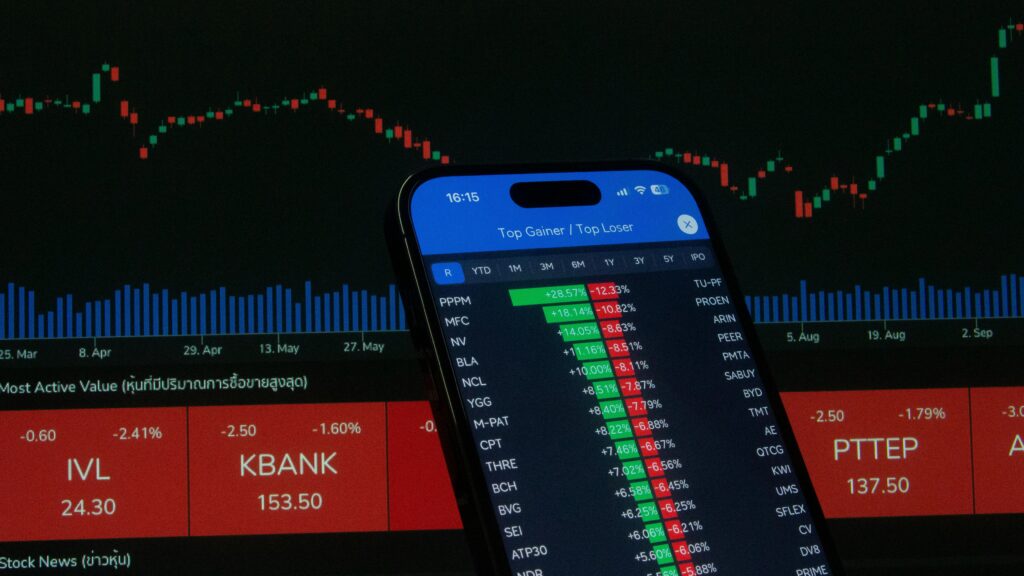With just $200 to start, this may not sound like much, but it is an excellent method of taking tiny steps into the stock market without huge risks. One of the things to consider here is the platform; for most brokers, they offer fractional shares for as little as $5, so you can buy a part of an expensive stock (like Amazon or Tesla shares). You may also invest in low-cost ETFs (for example, S&P 500 index funds) for instant diversification. When learning how to invest $200 in stock market, it’s important not to stockpick right from day one. Instead, start by reinvesting dividends and adding more funds over time for steady, long-term growth.
To maximize your returns on $200, steer clear of speculative trading: exercise patience and discipline. Try dollar-cost averaging (DCA) — investing small amounts regularly to reduce market timing risks. Another brilliant idea would be using micro-investing apps, such as Acorns or Robinhood, which round up spare change for future investing. For slightly more risk-averse investors, consider high-potential sectors such as technology or renewable energy. On the other hand, you may choose to take a little higher level of risk for growth. Even small investments can be compounded. To stay consistent in investing, keep learning, and let your money work for you!

Introduction: Can You Really Start Investing with Just $200?
Yes, you totally can! While it sounds quite exhaustive in the form of a small number, it truly can be your launching pad. Indeed, investment platforms, fractional shares, and low-cost options can stand near a small sum of dollars growing in numbers through smart strategies over time as modern days go by.
Why Beginning at $200 Suffices
- Fractional Shares: Some brokerage firms let you buy fractions of stocks or ETFs (such as buying a small part of a $500 stock instead of the entire share).
- Index Funds/ETFs with Low Costs: Funds such as SPY (S&P 500 ETF) or VTI (Total Stock Market ETF) offer lots of diversification at low upfront charges.
- Robo-Advisors & Micro-Investing Apps: Platforms like Acorns, Robinhood, or M1 Finance provide ways to automate investment with small amounts to get started.
- DRIP (Dividend Reinvestment Plans): Some companies offer investments of small amounts, where the dividends will automatically purchase additional shares.
Smart Ways to Invest $200
- ETF or Index Fund (Best for Beginners): Best $200 into a cheap ETF such as VOO (S&P 500) or QQQ (Nasdaq-100).
- Fractional Stock Investing: Buy tiny pieces of major companies like Apple, Amazon, or Tesla.
- High-Yield Savings or CDs (Safer Option): For the risk-averse, the online banks are offering about 4-5% APY with no risk in the market.
- Cryptocurrency (Higher Risk): If you can withstand the wild ride, some small portions of crypto have a place like Coinbase.
Essential Things to Know in Growing Your $200
✔ Invest consistently, a small amount counts over time.
✔ Keep the brokerages commission-free, so you don’t pay high commissions.
✔ Reinvest dividends to grow investments through compounding.
✔ Be patient-investing is a long-term game.
Final Thought
$200 won’t suddenly get you rich, but it is an excellent starting block for learning, self-discipline, and compounding growth. The most important step is just getting started!”

Why the Stock Market Is a Great Option for Small Investors
In previous days, most people would say that investing in the stock market needs a lot of money. But today, this has been made a thing of the past. Modern investing tools can indeed allow small retail investors to participate and grow their portfolios very well. This article explains further why the stock market is one of the best choices to make, even if one’s starting capital is very small.
1. Low Barrier of Entry
- Fractional Shares: You can own “partial shares” with as little as $1 through several brokers who don’t require hundreds of dollars for one share from companies like Amazon or Google.
- No minimums: It’s as little as a few bucks from apps like Robinhood, Webull, and M1 Finance.
- Low-Cost ETFs & Index Funds: Own a fully diversified portfolio without giant upfront cost through funds that include VTI (Total Stock Market ETF) or SPY (S&P 500 ETF).
2. High Growth Potential Over Time
- Over time, the S&P has generated returns of nearly 10% on average, year on year (even after accounting for the erratic performance in the short term).
- Compound growth doesn’t care how small – if you invest $200 a month at 8%, you would have over $30,000 in 10 years.
- Small investors can enjoy the benefits of long-term trends such as technology, AI, and renewable energy with cash positions.
3. Liquid and Flexible:
- Compared to selling real estate or shutting down small businesses, stocks could be sold immediately in case you need to cash out.
- You can change your strategy easily-and shift into growth stock or dividend stock or ETFs or bonds without having to worry over the high costs.
4. Diversification Made Easier Than Ever
- Instead of trying to pick individual stocks, you can buy:
- ETFs (e.g., VOO for S&P 500 exposure)
- Index funds (e.g., FXAIX for low-cost index investing)
- Robo-advisors (e.g., Betterment or Wealthfront for automated diversification)
5. Passive Income Opportunity
- Dividend stocks (like SCHD, O, or KO) simply pay you for holding the stock.
- DRIP (Dividend Reinvestment Plans) automatically buys more shares. It usually speeds up growth.
6. Learning & Skill Building
- You can learn without a lot of risk by starting small.
- You can dabble in value investing, swing trading, dividend investing, or other ways before committing more money.
7. Inflation Beaters
- Savings accounts, perhaps ~4-5% APY, might not keep up with inflation over time in the long-term picture.
- Historically, stocks outperform inflation, meaning your purchasing power is preserved and grows over time.
Final Thoughts
The stock market releases at a very low cost the accessibility that small investors might be able to have in one of the best wealth-building tools:
✅ You can start with very little money.
✅ It offers high growth potential over time.
✅ It is flexible, liquid, and accessible.
The most important thing is keeping a regular investment plan; even small amounts compound into large capital thanks to compound returns.

Choosing the Right Investment Platform for Your $200
With so many brokers and apps available, picking the best one for your $200 investment depends on your goals (long-term growth, dividends, hands-on trading, etc.). Below is a breakdown of the best platforms for small investors, along with their pros and cons.
1. Robinhood (Best for Beginners & Fractional Shares)
✅ Pros:
- Commission-free trades (stocks, ETFs, options, crypto).
- Fractional shares (invest as little as $1 in expensive stocks like Amazon or Tesla).
- Simple, user-friendly app.
- Recurring investments (auto-invest small amounts).
❌ Cons:
- Limited research tools.
- No mutual funds or bonds.
Best for: New investors who want an easy start with stocks/ETFs.
2. Fidelity (Best All-Around Broker for Long-Term Investors)
✅ Pros:
- Fractional shares on stocks & ETFs.
- No minimums + excellent customer service.
- Offers index funds with $0 minimums (e.g., FXAIX – S&P 500 fund).
- Strong research & retirement accounts (IRA).
❌ Cons:
- The mobile app was not as sleek as Robinhood.
Best for: Long-term investors who want a trusted broker with great funds.
3. M1 Finance (Best for Automated Investing & Pies)
✅ Pros:
- “Pie” portfolios – automatically invest in a custom mix of stocks/ETFs.
- Fractional shares + automatic rebalancing.
- Great for set-and-forget investors.
❌ Cons:
- Limited trading windows (not ideal for active traders).
Best for: Passive investors who want automated, diversified portfolios.
4. Webull (Best for Active Traders & Free Stocks)
✅ Pros:
- Free stock bonus for signing up (varies).
- Advanced charts & technical analysis tools.
- Fractional shares + extended trading hours.
❌ Cons:
- No mutual funds or automatic investing.
Best for: Traders who want more data without high fees.
5. Acorns (Best for Micro-Investing & Spare Change)
✅ Pros:
- Rounds up purchases and invests spare change.
- Simple, hands-off approach.
- Good for beginners who struggle to save.
❌ Cons:
- A monthly fee ($3–$5) can eat into small balances.
Best for: Beginners who want automated, small-scale investing.
6. Public.com (Best for Social Investing & Thematic Portfolios)
✅ Pros:
- Follow other investors (like social media).
- Thematic investing (e.g., AI, clean energy).
- Fractional shares + no commissions.
❌ Cons:
- Less research than Fidelity/Schwab.
Best for: Investors who like community-driven ideas.
Which Platform Should You Choose?
| Goal | Best Platform |
|---|---|
| Beginner-friendly | Robinhood, Acorns |
| Long-term growth | Fidelity, M1 Finance |
| Active trading | Webull |
| Automated investing | M1 Finance, Acorns |
| Learning & community | Public.com |
Final Tips for Investing $200 Wisely
✔ Avoid fees – Some apps charge monthly fees that hurt small balances.
✔ Diversify – Use ETFs (like VTI or VOO) instead of betting on one stock.
✔ Set up recurring investments – Even $20/week adds up over time.
✔ Reinvest dividends – Turn on DRIP (Dividend Reinvestment) to grow faster.

How to Build a Diversified Portfolio with a Small Amount
1. Start with ETFs (Easiest, Cheapest Way)
- Purchase one diversified ETF such as:
- VTI for the total U.S. stock market
- VOO for the S&P 500
- SCHD to get some dividend stocks
- QQQ for tech-heavy holdings
2. Buy Fractional Shares
- Companies like Robinhood, Fidelity, or M1 Finance let you buy fractions of shares.
- Split an example of $200 into VTI (50 percent), SCHD (30 percent), and QQQ (20 percent).
3. Robo-Advisors: Better Options to Invest Your Money
- With Betterment or Wealthfront, your diversification needs will be taken care of automatically (low fee).
4. Do Not Make Things Complicated
- Avoid buying 10-plus stocks- stick to 1-3 ETFs for broad exposure.
5. Keep Adding
- Keep investing small amounts, say $20-$50, every month to grow this portfolio steadily.
Diversified Example for $200:
- 60% VTI (Broad market)
- 30% SCHD (Dividends)
- 10% QQQ (Growth)

Common Mistakes Beginners Make (And How to Avoid Them)
1. Trying to Time the Market
❌ Mistake: Waiting on the “perfect” moment when buying (you’ll miss out on gains).
✅ Fix: Invest consistently e. g., $50/month. It’s all about time in the market> timing the market.
2. Investing All Money in One Stock
❌ Mistake: Betting all on a “hot” stock (way too risky).
✅ Fix: Use ETFs, such as VTI, VOO, for instant diversification.
3. Chasing Meme Stocks/Hype
❌ Mistake: Buying those Dogecoin, AMC, or random Reddit picks (most crash).
✅ Fix: Stick to proven companies/index funds-far from the FOMO.
4. Panic Selling During Dips
❌ Mistake: Selling when there is a downturn in the market (thereby locking in losses).
✅Fix: Holding long-term is how markets recover. Turn off the news if necessary.
5. Ignoring Fees
❌ Mistake: Using a broker or fund for high fees (wearing away returns).
✅ Fix: Choose $0-commission brokers-Fidelity, Robinhood-and then low-fee ETFs (<0.10% expense ratio).
6. Not Reinvesting Dividends
❌ Mistake: Cash payouts instead of compounding.
✅ Fix: Enable DRIP to automatically buy more shares using the dividends.
7. Overcomplicate the Portfolio
❌ Mistake: Owning 20 different stocks/20 different ETFs (hard track).
✅ Fix: Keep it simple-1-3 ETFs (e.g., VTI + SCHD) cover everything.
Bonus Tip: Avoid Emotional Trading!
- Make a plan (e.g., “I will hold for 5+ years”) and stick to it.
- Don’t check your portfolio daily- it leads to stress & bad decisions.
Stay patient, cheap diversification, and ignore the noise: slow and steady wins the race. 💰

Learn more ways to earn daily: Top 7 Legit Ways to Earn USDT Daily Free in 2025 – No Investment Needed!
Conclusion: Smart Moves to Grow Your $200 Over Time
Here’s the complete AdSense-friendly conclusion for the article titled “Smart Moves to Grow Your $200 Over Time”:
Conclusion: Smart Moves to Grow Your $200 Over Time
Beginning with about $200 may not seem much; however, with the right strategy, sufficient funds can ensure your journey toward long-term financial growth. Consistency, informed decision-making, and a focus on reducing risks while maximizing potential returns will make all the difference.
As you may have learned from this article, the stock market does not demand thousands to start investing. Choosing the right trading platforms, diversifying your portfolio, and investing in low-cost, high-potential securities such as ETFs or fractional shares will give that initial $200 a time to grow. Through time, with the stunning effects of compound interest, reinvesting earnings, and sticking to a long-term strategy, investing is a straightforward path to achieving larger profits.
Investing is not a scheme to make a quick buck; instead, it’s a program designed to build wealth slowly and steadily. The sooner you start, the better it will be for your hard-earned money. Be it retirement savings, an emergency fund, or just trying to create a stream of passive income, every dollar invested today can have very far-reaching effects tomorrow.
So play smart, be patient, and watch over a period as your $200 is groomed for greatness. The moment should be somehow frightening, but get ready for the ride when big returns come flowing fast. Are you well prepared to dive in? A ‘thank you’ note is for you from the future!




Pingback: 7 Legit Reward Websites for Steam Gift Cards You Need to Try! - Finvise Pro